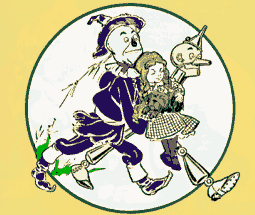The Wonderful Wizard of Oz

When it was first published in 1900, The Wonderful Wizard of Oz was hailed as "The American Alice in Wonderland."
Well, it just isn't. Both works have young female protagonists. Both stories have the main character trying to reach a goal (the lovely garden, the way back to Kansas). Both are children's fantasies. Beyond that, the two are really very different.
For one thing, the Baum work is not as tightly unified; it's a series of digressions really. Dorothy is two-dimensional compared to Alice; her character does not grow (that is not a pun :) the way Alice does as the story progresses. On the whole, The Wonderful Wizard of Oz is much simpler and less sophisticated than Carroll's story, and it doesn't offer much more depth on a second or third reading.
Some have suggested the work is symbolic, an economic allegory (see "The Cross of Gold and the Wizard of Oz" for an interesting analysis), even though Baum claimed there was no symbolic significance in his book (then again, neither did Carroll about his Alice book; you can't always believe authors).
In any case, the book does not invite several reasonable interpretations.
Griffith and Frey list what Baum seems to have been most interested in in writing his story:
He was interested in scenes where characters confront simple, definite physical problems, and solve them. (Pursued by the Kalidahs, the Tin Woodman makes a bridge by felling a tree and then destroys it before they can follow. Faced with the question of how to move a 400-pound lion out of a poppy field, the Scarecrow mobilizes thousands of mice to pull a jerry-built truck. To fight off wolves, the Ti Woodman uses his ax; to fight off crows, the Scarecrow scares them; to fight off bees, the party covers its vulnerable members with straw and lets the bees destroy themselves against the Woodman's tin. To rescue the Scarecrow from the middle of a river, they enlist the aid of a friendly Stork. And so forth.)
He's interested in the simple pleasure of moving through a foreign world and finding a place to sleep, chance to wash up, and food to one's liking. (This scene occurs ten times in the story's twenty-three chapters.)
He's interested in implications that would follow "realistically" from unrealistic fairy-land premises. (If a Scarecrow were alive, he would be most afraid of fire, but he would not need to eat or sleep. If a sentimental man were re-cast in metal, his tendency to weep would be a problem for it could make him rust. If people were made of china, they would break easily, mend easily, but the cracks would show. If everyone wore green glasses inside a certain city, they would think everything in the city was green.)
He's interested in problems that turn out to be a lot easier than they seemed. (To kill a Wicked Witch, all Dorothy has to do is let the mark of the Good Witch's kiss protect her, and throw an ordinary bucket of water on the villainess. In order to grant the Scarecrow's, Woodman's, and Lion's wishes, all the Wizard has to do is give them any old thing and call it brains, heart, and courage. In order to get back to Kansas, all Dorothy has to do is click her heels and wish to be there.)
The book is fun, whimsical, fantastical; it was and still it incredibly popular. It doesn't have the depth of Alice in Wonderland, but not much in children's literature does.
Since the Victor Fleming film version of The Wizard of Oz is so popular, it invites comparison with the book. Many feel here is a case where the movie is better than the book. The movie develops the central character more fully. The theme is more fully-developed as well: In the book when Dorothy wants to go back to the "great gray prairie" where there is little joy or interest, readers often wonder why (it just seems like a place to go for convention's sake); in the movie, Dorothy's adventure/dream is built of representations of her real (Kansas) world, and when she returns, it's to the realization that even though there is unfriendliness in her world, there is also friendship, support, and love. The screenwriters also weeded out a lot of the less successful (or less integral) scenes; as a result, the film is tightly unified; it feels like a single story rather than a patchwork quilt of episodes.
The success of the book and the film spawned many sequels. After finishing The Wonderful Wizard of Oz, Baum thought he was done with it, but much to his chagrin the remarkable demand for more Oz from readers (and, no doubt, Baum's literary agent), pushed him to write several other Oz books, and a number of film and cartoon versions of the stories have been, and continue to be, made.